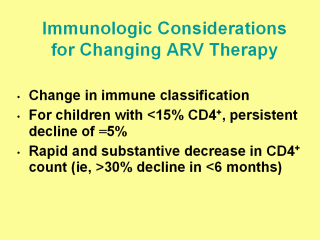| front |1 |2 |3 |4 |5 |6 |7 |8 |9 |10 |11 |12 |13 |14 |15 |16 |17 |18 |19 |20 |21 |22 |23 |24 |25 |26 |27 |28 |review |
 |
Before considering changing antiretroviral
therapy because of a decline in CD4+ T cell values, a minimum of one
repeated measurement of CD4+ T cell values should be obtained at least 1
week after the initial test. Potent antiretroviral therapy usually increases CD4+T cell values. Failure of a regimen to improve CD4+T cell values for patients in immune category 3 should prompt review of the available treatment options and possible change in the antiretroviral regimen. CD4+ T cell count and percentage are independent predictors of disease progression and mortality in HIV-infected children [38, 39]. The association of HIV RNA and CD4+ T cell percentage with long-term mortality risk in HIV-infected children has been evaluated; for each absolute decline of five percentiles in CD4+ T cell percentage at baseline or during follow up, the mortality risk ratio increased by 1.3 (95% CI=1.2–1.5), independent of the child’s HIV RNA level [38]. For children with CD4+ T cell percentages of <15% (i.e., those in immune category 3), prognosis also was correlated with the degree of depression of CD4+ T cell percentage (i.e., life expectancy was less for children with CD4+ T cell percentages of <5% compared with children with CD4+ T cell percentages of 10%–14%) (Table 3). |